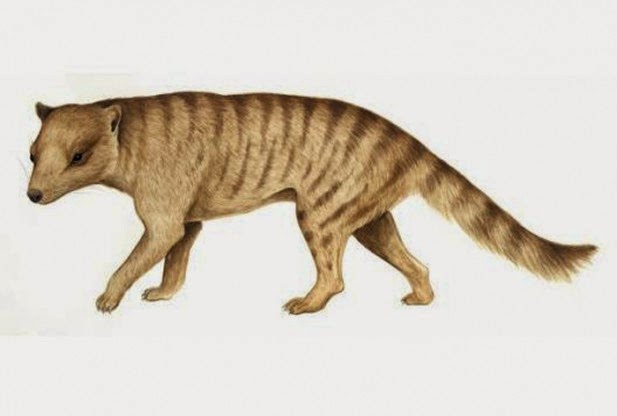The biggest known carnivorous marsupial of the modern era – the Tasmanian tiger – or thylacine – went extinct in the early 20th century.
Now, researchers have found that a distant, ancient relative of the thylacine was able to hunt down prey larger than itself, according to a new study in the open-access journal PLOS ONE.
Based solely on a recovered 16- to 11.5-million-year-old skull, the study team was able to create a virtual three-dimensional model of the fox-sized carnivore called Nimbacinus dicksoni and compared that model to models of other large living marsupial carnivores, including the Tasmanian devil and Tasmanian tiger.
The team’s comparisons revealed similarities to the mechanical performance of the spotted-tailed quoll, a cat-sized carnivorous marsupial native to Australia. The mechanical similarities told the study team that N. dicksoni had a strong bite force for its size, was mostly carnivorous, and was probably capable of taking down vertebrate prey that weighed more than itself.
“Our findings suggest that Nimbacinus dicksoni was an opportunistic hunter, with potential prey including birds, frogs, lizards and snakes, as well as a wide range of marsupials,” said study author Marie Attard of the University of New England in a statement.
“In contrast, the iconic Tasmanian tiger was considerably more specialized than large living dasyurids and Nimbacinus, and was likely more restricted in the range of prey it could hunt, making it more vulnerable to extinction,” said Attard, who worked on the study as part of her doctoral research at the University of New South Wales in Australia.
UNSW researchers have been working in the Riversleigh World Heritage Fossil Site where the skull was found for 37 years.
“What makes this study of mechanical capacity possible is also what makes Riversleigh globally so stunning – a deliciously high biodiversity of weird and wonderful creatures, and simply extraordinary preservation,” said study author Mike Archer, a professor in the UNSW School of Biological, Earth and Environmental Sciences.
The study team noted that the cave where the N. dicksoni skull was found has also produced hundreds of other valuable fossil specimens.
“It was a very exciting deposit to work, with skulls and skeletons popping up all over the place as we excavated each ancient floor, one on top of another, that had filled up the cave,” Archer said. “And of course it’s just one of more than 200 fossil-rich sites spanning the last 26 million years at Riversleigh, with more new sites being found every year.”
“The Nimbacinus skeleton was one of the first and most amazing things we encountered in the AL90 deposit. Apart from the modern species, it is the only other extinct thylacinid skeleton known and has provided many insights into the evolutionary origins and behaviors of Australia’s carnivorous marsupials,” he continued.
“We found, from the posture of the skeleton, that it had given up trying to get out of the cave into which it had fallen so long ago. It had folded its arms, and put its head down for a quiet little 15 million-year-long nap. Hence, we nick-named it the ‘Philosophical Thylacine’,” Archer said.
Image 2 (below): This is a photo of Mid Miocene Nimbacinus dicksoni skull and dentition emerging. Credit: Anna Gillespie, University of New South Wales
Source: Here
skip to main |
skip to sidebar
Popular Posts
-
In certain areas of the world, there are actual creatures that look like they came from a medieval legend. They’re usually uncommon and hard...
-
Patsy Kensit feet pictures, Patsy Kensit legs, Patsy Kensit toes, Patsy Kensit barefoot and shoes. Patsy Kensit is a delightful English actr...
-
Portia de Rossi feet pictures, Portia de Rossi legs, Portia de Rossi toes, Portia de Rossi barefoot and shoes. Portia de Rossi is a pretty A...
Powered by Blogger.
Blog Archive
- June 2014 (19)
- May 2014 (39)
- April 2014 (43)
- March 2014 (49)
- August 2013 (132)
- July 2013 (25)
- June 2013 (53)
- May 2013 (52)
- April 2013 (38)
- December 2012 (40)
- November 2012 (110)
- July 2012 (4)
- June 2012 (75)
- May 2012 (71)
- March 2011 (6)
- January 2011 (519)
- December 2010 (38)
- November 2010 (39)
- October 2010 (80)
- September 2010 (72)
- August 2010 (132)
- July 2010 (222)
- June 2010 (246)
- May 2010 (157)
- April 2010 (91)
- March 2010 (75)
- February 2010 (76)
- January 2010 (44)
- December 2009 (33)
- November 2009 (52)
- October 2009 (50)
- September 2009 (64)
- August 2009 (35)
- July 2009 (47)
- June 2009 (23)
- May 2009 (18)
- April 2009 (15)
- March 2009 (17)
- February 2009 (14)
- January 2009 (13)
- December 2008 (24)
- November 2008 (30)
- October 2008 (40)
- September 2008 (34)
- August 2008 (41)
- July 2008 (40)
- June 2008 (24)



